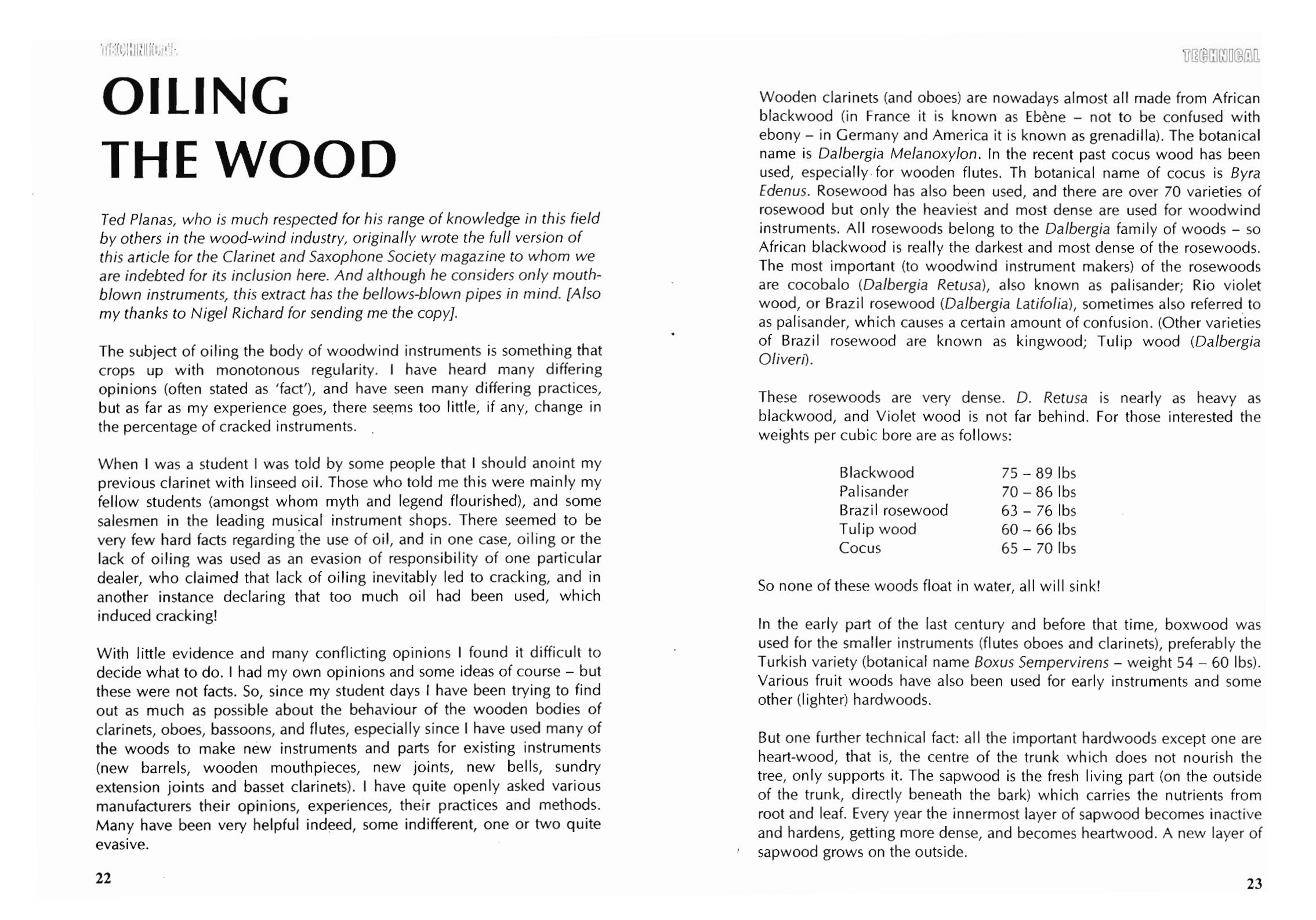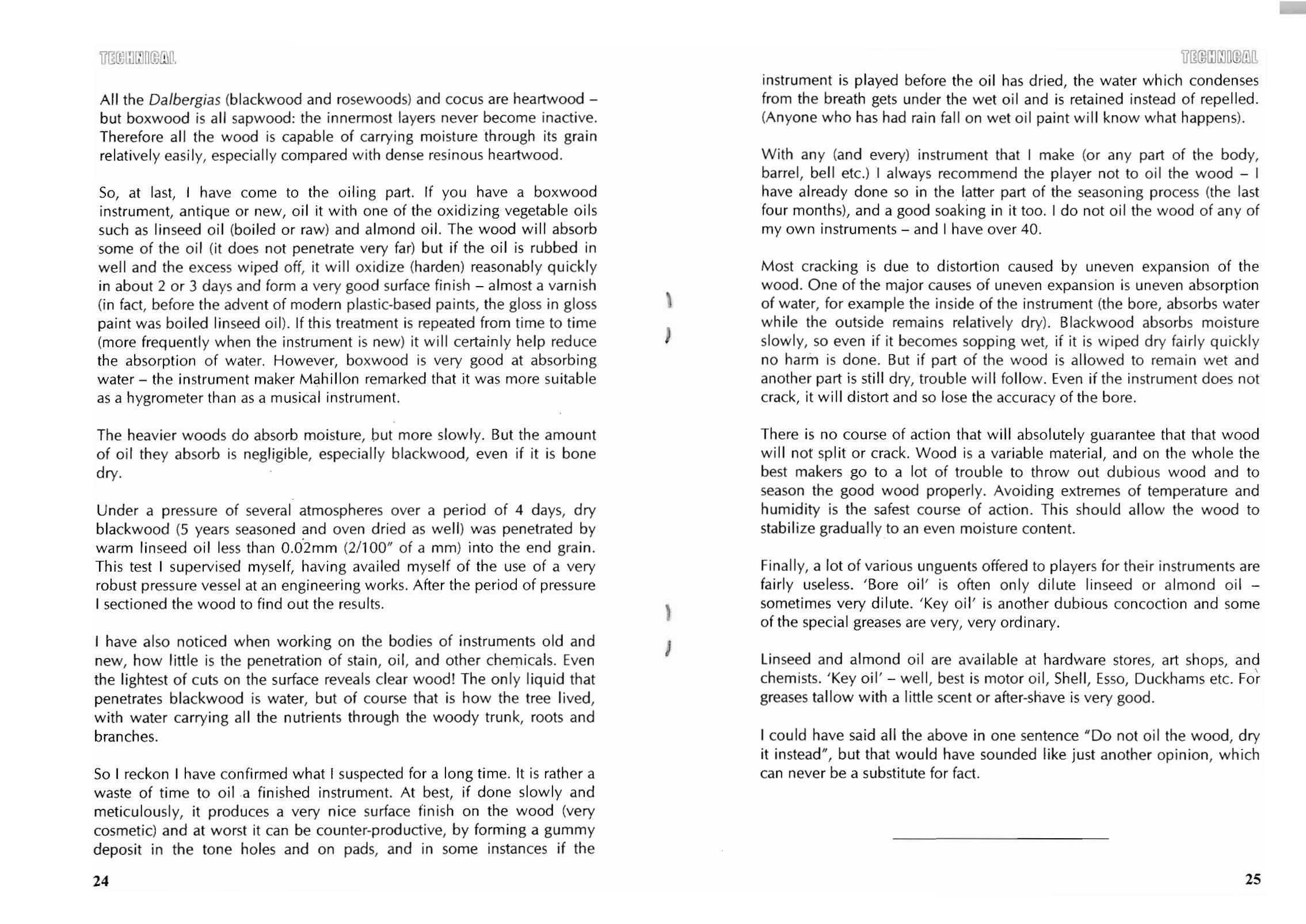Oiling the Wood


Ted Planas, who is much respected for his range of knowledge in this field by others in the wood-wind industry, originally wrote the full version of this article for the Clarinet and Saxophone Society magazine to whom we are indebted for its inclusion here. And although he considers only mouth- blown instruments, this extract has the bellows- blown pipes in mind. [Alsomy thanks to Nigel Richard for sending me the copy].
The subject of oiling the body of woodwind instruments is something that crops up with monotonous regularity. I have heard many differing opinions (often stated as ‘fact’), and have seen many differing practices, but as far as my experience goes, there seems too little, if any, change in the percentage of cracked instruments.
When I was a student I was told by some people that I should anoint my previous clarinet with linseed oil. Those who told me this were mainly my fellow students (amongst whom myth and legend flourished), and some salesmen in the leading musical instrument shops. There seemed to be very few hard facts regarding the use of oil, and in one case, oiling or the lack of oiling was used as an evasion of responsibility of one particular dealer, who claimed that lack of oiling inevitably led to cracking, and in another instance declaring that too much oil had been used, which induced cracking!
With little evidence and many conflicting opinions I found it difficult to decide what to do. I had my own opinions and some ideas of course - but these were not facts. So, since my student days I have been trying to find out as much as possible about the be- haviour of the wooden bodies of clarinets, oboes, bassoons, and flutes, especially since I have used many of the woods to make new instruments and parts for existing in- struments (new barrels, wooden mouthpieces, new joints, new bells, sundry exten- sion joints and basset clarinets). I have quite openly asked various manufacturers their opinions, experiences, their practices and methods. Many have been very helpful indeed, some indifferent, one or two quite evasive.
Wooden clarinets (and oboes) are nowadays almost all made from African blackwood (in France it is known as Ebene - not to be confused with ebony - in Germany and America it is known as grenadilla). The botanical name is Dalbergia Melanoxylon. In the recent past cocus wood has been used, especially for wooden flutes. Th botanical name of cocus is Byra Edenus. Rosewood has also been used, and there are over 70 varieties of rosewood but only the heaviest and most dense are used for woodwind instruments. All rosewoods belong to the Dalbergia family of woods - so African blackwood is really the darkest and mostdense of the rosewoods. The most important (to woodwind instrument makers) of the rosewoods are cocobalo (Dalbergia Retusa), also known as palisander; Rio violet wood, or Brazil rosewood (Dalbergia Latifolia), sometimes also referred to as palisander, which causes a certain amount of confusion. (Other varieties of Brazil rosewood are known as kingwood; Tulip wood (Dalbergia Oliveri).
These rosewoods are very dense. D. Retusa is nearly as heavy as blackwood, and Violet wood is not far behind. For those interested the weights per cubic bore are as follows
Blackwood 75 - 89 lbs
Palisander 70 - 86 lbs
Brazil rosewood 63 - 76 lbs
Tulip wood 60 - 66 lbs
Cocus 65 - 70 lbs
So none of these woods float in water, all will sink!
In the early part of the last century and before that time, boxwood was used for the smaller instruments (flutes oboes and clarinets), preferably the Turkish variety (botanical name Boxus Sempervirens - weight 54 - 60 lbs). Various fruit woods have also been used for early instruments and some other (lighter) hardwoods.
But one further technical fact: all the important hardwoods except one are heart-wood, that is, the centre of the trunk which does not nourish the tree, only supports it. The sap- wood is the fresh living part (on the outside of the trunk, directly beneath the bark) which carries the nutrients from root and leaf. Every year the innermost layer of sap- wood becomes inactive and hardens, getting more dense, and becomes heartwood. A new layer of sapwood grows on the outside
All the Dalbergias (blackwood and rosewoods) and cocus are heartwood - but boxwood is all sapwood: the innermost layers never become inactive. Therefore all the wood is
capable of carrying moisture through its grain relatively easily, especially compared with dense resinous heartwood.
So, at last, I have come to the oiling part. If you have a boxwood instrument, antique or new, oil it with one of the oxidizing vegetable oils such as linseed oil (boiled or raw) and almond oil. The wood will absorb some of the oil (it does not penetrate very far) but if the oil is rubbed in well and the excess wiped off, it will oxidize (harden) rea- sonably quickly in about 2 or 3 days and form a very good surface finish - almost a varnish (in fact, before the advent of modern plastic-based paints, the gloss in gloss paint was boiled linseed oil). If this treatment is repeated from time to time (more frequently when the instrument is new) it will certainly help reduce the absorption of water. However, boxwood is very good at absorbing water - the instrument maker Mahillon remarked that it was more suitable as a hygrometer than as a musical instrument.
The heavier woods do absorb moisture, but more slowly. But the amount of oil they absorb is negligible, especially blackwood, even if it is bone dry.
Under a pressure of several atmospheres over a period of 4 days, dry blackwood (5 years seasoned and oven dried as well) was penetrated by warm linseed oil less than 0.02mm (2/100" of a mm) into the end grain. This test I supervised myself, having availed my- self of the use of a very robust pressure vessel at an engineering works. After the pe- riod of pressure I sectioned the wood to find out the results.
I have also noticed when working on the bodies of instruments old and new, how little is the penetration of stain, oil, and other chemicals. Even the lightest of cuts on the sur- face reveals clear wood! The only liquid that penetrates blackwood is water, but of course that is how the tree lived, with water carrying all the nutrients through the woody trunk, roots and branches.
So I reckon I have confirmed what I suspected for a long time. It is rather a waste of time to oil a finished instrument. At best, if done slowly and meticulously, it produces a very nice surface finish on the wood (very cosmetic) and at worst it can be counter- productive, by forming a gummy deposit in the tone holes and on pads, and in some in- stances if the instrument is played before the oil has dried, the water which condenses from the breath gets under the wet oil and is retained instead of repelled. (Anyone who has had rain fall on wet oil paint will know what happens).
With any (and every) instrument that I make (or any part of the body, barrel, bell etc.) I always recommend the player not to oil the wood - I have already done so in the latter part of the seasoning process (the last four months), and a good soaking in it
too. I do not oil the wood of any ofmy own instruments - and I have over 40.
Most cracking is due to distortion caused by uneven expansion of the wood. One of the major causes of uneven expansion is uneven absorption of water, for example the inside of the instrument (the bore, absorbs water while the outside remains relatively dry). Blackwood absorbs moisture slowly, so even if it becomes sopping wet, if it is wiped dry fairly quickly no harm is done. But if part of the wood is allowed to remain wet and another part is still dry, trouble will follow. Even if the instrument does not crack, it will distort and so lose the accuracy of the bore.
There is no course of action that will absolutely guarantee that that wood will not split or crack. Wood is a variable material, and on the whole the best makers go to a lot of trouble to throw out dubious wood and to season the good wood properly. Avoiding ex- tremes of temperature and humidity is the safest course of action. This should allow the wood to stabilize gradually to an even moisture content.
Finally, a lot of various unguents offered to players for their instruments are fairly use- less. ‘Bore oil’ is often only dilute linseed or almond oil - sometimes very dilute. ‘Key oil’ is another dubious concoction and some of the special greases are very, very ordi- nary.
Linseed and almond oil are available at hardware stores, art shops, and chemists. ‘Key oil’ - well, best is motor oil, Shell, Esso, Duckhams etc. For greases tallow with a little scent or after-shave is very good.
I could have said all the above in one sentence “Do not oil the wood, dry it instead”, but that would have sounded like just another opinion, which can never be a substitute for fact.
